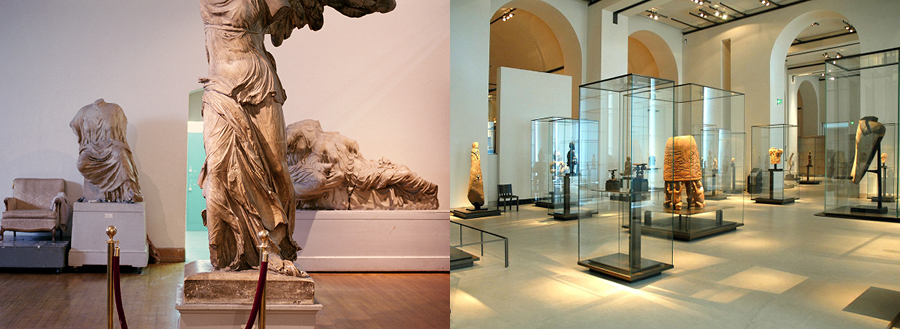
Art History Symposium: Canonicity Revisited
Friday, March 1, 2019 at 4:15pm
Boger Hall, Room 112, 41 Wyllys Avenue, Middletown
FREE!
Saturday, March 2, 2019 at 9:30am
Boger Hall, Room 112, 41 Wyllys Avenue, Middletown
FREE!
The symposium Canonicity Revisited is envisioned as a critical interrogation of the problem of canons and canonicity in art history. This subject was a matter of intense debate in the mid 1990s, unfurling across the pages of a number of major publications in the field. By then, revisionist approaches had already begun to transform the discipline’s operating assumptions about what constitutes its canonical texts and artifacts, and about the very meaning and value of canonicity itself. Art history’s reevaluation has only increased in recent years thanks to the crucial work, now decades in the making, of feminist, postcolonial, and queer interventions, and to the development of visual and cultural studies. Nevertheless, it seems to us that canons and their variants in many ways still shape—or perhaps haunt—both the teaching and scholarship of art history. What accounts for their persistence? And how do they bear down on art historical thinking today?
What has been the role of canons and canonicity in the development of art history as a discipline, in relation to both Western and non-Western and pre-modern and modern art? In what ways has the discipline of art history been intellectually confined by the received constellations of major works that canons define? Conversely, in what ways do canons provide methodologically indispensable reference points upon which debate and understanding rely? What types of structures do canonical texts, textbooks, and surveys create for art historical practice? How does the category of the “canonical” relate to the concept of “high art”? What distinct pressures do canons exert on museum practices, and what role do museums play in canon formation and perpetuation? In projecting canonicity’s underlying concepts of originality, timelessness, individual authorship, and greatness back in time, and onto globally varied contexts, what historical inaccuracies or distortions does art history inadvertently produce? What would it take for canons to answer to the increasingly global context of contemporary art and culture? By what mechanisms do canons change? What is the role of political or religious ideology in canon formation and revision? Does canonicity in art history function in the same way that it does in music, literature, or other fields of cultural production?
Sponsored by the Department of Art and Art History, Samuel Silipo '85 Distinguished Visitor's Fund, Virgil and Juwil Topazio Lecture Fund, Allbritton Center for the Study of Public Life, Dean of Arts and Humanities, Center for the Americas, Fries Center for Global Studies, College of East Asian Studies, and Center for the Humanities.
Click here to see photos from this event.
SCHEDULE
Friday, March 1
4:15PM
Introduction: Joe Siry, Wesleyan University, and Claire Grace, Wesleyan University
4:30PM
Opening Keynote: Caroline Jones, M.I.T., “Predicated Internationalism: ‘Peripheries’ and the Global Working of Art‘s History”
6:15PM
Reception and talk with a special viewing of artworks from the Davison Art Center collection: Miya Tokumitsu, Wesleyan University, “Canon and Collection,” Davison Art Center. (Talk is only open to symposium speakers, for reasons of space. The reception is open to all.)
Saturday, March 2
9:30–10:30AM
Canon | Nation
- Phil Wagoner, Wesleyan University, “Cannons [sic] and Canonicity: Expanding the Canon of Indian Art”
- Yunchiahn C. Sena, Trinity College, “The Morphing Images of Antiquity: Orthodox Chinese Iconography in Taiwan’s Vernacular Architecture under Japan”
- Open Discussion
Archaeologies of Knowledge
- Kishwar Rizvi, Yale University, “Chronophilia and the Canon: Islamic Architecture and the Entanglements of History”
- Claire Grace, Wesleyan University, “After Canons: The Arts and Letters of Tim Rollins and K.O.S.”
- Benjamin Chaffee, Wesleyan University, “Scaffolds”
- Open Discussion
Canon Formation and the Museum
- Risham Majeed, Ithaca College, “Primitive before Primitivism: Medieval and African art at the Trocadéro”
- Kathleen Curran, Trinity College, “Canonicity and the American Art Museum”
- Open Discussion
“Peripheries”
- Peter Mark, Wesleyan University (Emeritus), “On Being Outside the Canon”
- Melissa Katz, Wesleyan University, “Circling the Canons: Mimetic Sculpture in Medieval Spain”
- Open Discussion
Canon Formation and Social Upheaval
- Clark Maines, Wesleyan University (Emeritus), “Creating and Dismantling the Canon of Gothic Sculpture in France”
- Joe Siry, Wesleyan University, “Mies van der Rohe’s Crown Hall at the Illinois Institute of Technology: Creating and Critiquing the Modernist Canon”
- Open Discussion
Closing Keynote: Michael Cole, Columbia University, “Sofonisba Anguissola: Fame and Recognition”
Images (from left):
Louise Lawler, A.C.A.D.E.M.Y., 1987, Silver dye bleach print, 29 x 39 1/2 inches, 73.7 x 100.3 cm, (MP# LL-207). Courtesy of the artist and Metro Pictures, New York.
Le musée du Quai Branly au palais du Louvre, Pavillon des Sessions, 2009. Photograph by Jean-Pierre Dalbéra, Wikimedia Commons.